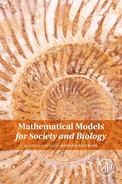Preface to the Second Edition
The book before you has the goal of showing how mathematics can illuminate fascinating problems drawn from society and biology. It assembles an unusual array of applications, many from professional journals, that either have not appeared before or cannot be found easily in book form. Moreover, the contexts of most chapters are current issues of real concern, in which the mathematics follows from the problems and not the other way around.
Some material from the first edition has been eliminated because it seemed to be of less relevance today, but much new matter has been added so that the original nine chapters has been expanded into the current twelve.
The present edition maintains the same basic outlook as the earlier version with regard to what I mean by the term modeling. In no instance do I think in terms of large-scale computational exercises. Instead, I strive for simplicity and clarity. A model is a suggestive metaphor, a fiction about the messy and unwieldy observations of the real world. In order for it to be persuasive, to convey a sense of credibility, it is important that it not be too complicated and that the assumptions be clearly in evidence. In short, the model should be simple, transparent, and verifiable. Put another way, models are viewed as organizing principles that enable one to handle a vast and confusing array of facts in a parsimonious manner, and they are useful to the extent that they reveal something of the underlying dynamics, providing a measure of insight into a complex process. Although such models rarely replicate reality, they can serve as indicators for what is going on, a bit of a caricature perhaps but informative nonetheless. The celebrated mathematician Alan Turing put it best when he wrote, in a paper that we study in the penultimate chapter, “This model is a simplification and an idealization and, consequently, a falsification. It is hoped that the features retained for discussion are those of the greatest importance in the present state of knowledge.” In short, there should be a balance between sufficient complexity to mimic the essential dynamics of the underlying process and a respect for simplicity in order to avoid getting tangled in extraneous and irrelevant details. That’s the way we do it in this book.
This volume is definitely not a text, nor is it suitable to train biologists or sociologists, since the math employed is generally beyond what these students learn in their usual coursework. Instead, it is a reference for mathematically prepared students (undergraduate) consisting of interesting and unusual applications to the biological and social sciences, a resource for self-study.
The chapters are individual essays for learning how mathematics can be used to model real problems in areas other than engineering and physics and are loosely interconnected, if at all. Each chapter begins with the sociological or biological context, assuming no special background other than what a layperson would acquire from reading newspapers such as the New York Times (my home paper). Then there is a transition to discuss how to formulate a reasonable model to gain insight into some specific question that has been introduced. This then morphs into the mathematics itself, discussing what is relevant. However, since I do not want this to be a book that is primarily about mathematical techniques, many details are left to easily accessible references, except for certain less commonly encountered technical niceties that are introduced within each chapter or that are relegated to an appendix. Though each chapter is essentially an isolated essay, some ideas and techniques do recur in later chapters, and this helps to give a new perspective to what was previously covered in a different context.
As for prerequisites, I assume that a student has had the conventional training expected of a junior-level student, including basic results from multivariate calculus and matrix theory and some elementary probability theory and linear differential equations. More exotic material is explained in the text, and, as already noted, in the few places where relatively sophisticated tools are required I provide appropriate references to where details can be found. Generally speaking, a sprinkling of chapters from the two excellent undergraduate texts on probability by Sheldon Ross [99,100] and a similar selection from the superb undergraduate text on differential equations by Hirsch, Smale, and Devaney [62] suffice to cover the bulk of the technical details required for an understanding of the present work.
The wide range of topics discussed covers, in biology alone, questions from biochemistry, molecular biology, microbiology, epidemiology, embryology, and ecology. As for the rest, problems of social mobility, fair representation, criminal justice, medicine, finance, sports, municipal services, and the like all make their appearance, each accompanied by references to current events and personalities who headline the news. Hopefully this helps to enliven the discussion and provide a context for the modeling issues.
Acknowledgments
A number of colleagues at Stony Brook, past and present, have influenced the development of this book by their work at the interface between mathematics and the other sciences. Indeed, there is hardly a chapter in the book that doesn’t incorporate, to some extent, the inspired research of a Stony Brook scientist. These include Akira Okubo of the Marine Sciences Research Center, Ivan Chase of the Sociology Department, Jolyon Jesty of the Health Sciences Hematology Department, William Bauer of Microbiology, Larry Slobodkin of Ecology and Evolution, Larry Bodin of the Harriman School of Public Policy, and Michel Balinski from Applied Mathematics.
I want to extend my sincere thanks to the following individuals for their helpful reviews of the first edition of my manuscript: Jayne Ann Harder, University of Texas, Austin; Bruce Lundberg, University of Southern Colorado; Thomas Seidman, University of Maryland; Robert White, North Carolina State University, Raleigh; and Daniel Zelterman, Yale University.
